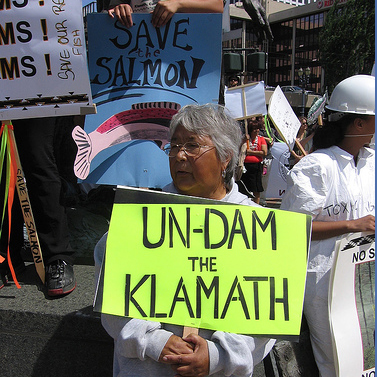Interior Chief to California: Don’t allow significant water supply and infrastructure projects be derailed

Today at the Commonwealth Club in San Francisco, Secretary of the Interior Ken Salazar weighed in on three major water projects in the state and called on Californians to “stand firm” and defend the “hard-gained agreements and settlements” built in past decades.
“Never before have water agreements that provide safety and certainty for Westerners been so at risk,” said Salazar, referring to debates over the future of the San Joaquin River, the California Bay Delta, and the Klamath River.
Salazar argued that the state, and the country, should not back away from the 2006 San Joaquin River Restoration Program settlement, which, he said enabled the river to run from its headwaters to the ocean this year for the first time in half a century. He lobbied for the Bay Delta Conservation Plan, calling it a “comprehensive approach that includes new habitat for endangered fish species, coordinated measures to attack toxics that are fouling delta waters, and improvements to the state’s water infrastructure.”
Salazar said he will be ruling on the proposal to remove four dams along the Klamath River in March of next year. In recent years both fish populations and agricultural interests have suffered from drought along the oversubscribed river. In 2009, negotiators representing a wide array of interests agreed on a settlement that would remove four hydroelectric dams by 2020 as part of an agreement to restore historic salmon runs while keeping irrigation for the region’s farmers.
Salazar said Monday that the cost of removing the dams would be $290 million, far less than the $450 million originally estimated. He offered a preview of the impacts of the dam removals and river restoration, according to the DOI’s Draft Environmental Impact Statement, which is due to be released Thursday. The report includes the following findings, he said:
- Loss of hydroelectric power
- Loss of 50 power generation management jobs
- Loss of some recreational opportunities
- Decrease in some nearby property values
- Addition of 4,600 jobs to the regional economy over 15 years, including 1,500 during dam removal
- Increased water reliability to boost farm income and add between 70 and 695 agriculture jobs annually
- Improved conditions for salmon fishermen, creating 400 jobs
Salazar said that California and the West are facing a critical time for decisions about the region’s water supply. Both population growth and climate change will add stress to an already stressed system, he said.
“Climate change is happening,” he said. “We can’t ignore this reality. It does no good to blame the scientists or to bury our heads in the sand.”
3 thoughts on “Salazar: Risky Times for Western Water”
Comments are closed.

I have just read a 1995 publication of The Layman’s Guide to California Water published by the Water Education Foundation. I find it scary to compare the description of the current Bay Delta Conservation Plan with the goals described 16 years ago. The difference was that the Layman’s Guide was extolling the virtues of Cal-FED and we know what a failure that was.
It makes one ask whether we have fixed the basic reasons for failure including a lack of good governance and the unwillingness to fund the actions that were required. The answer is a resounding “No”.
On top of this, the current plan is a true job killer for the Delta. Restore the Delta’s press release today covers this very well. Of course, Salazar made his pitch in line with the administration’s jobs plan. But not everyone is above a little spin, not even the Sec. of the Interior.
Sorry I got sloppy with cut and pasted. Good link is: http://campaign.r20.constantcontact.com/render?llr=xp76ilcab&v=001rBBS2uM5H3-5Vj149b0DT7rs9fu1fcRdzFVqy8XW7eRZi51-E_RUBCzwRYWI3vHl6F31FA1-QMMaCLRdaXP82LTAQroAq-jJgwTmFj8sQB5FR_ND6IcMfDfL7m0t9s8d
Thanks for the additional resource, Wes. Here’s a shorter version of that link:
http://bit.ly/oZee9H